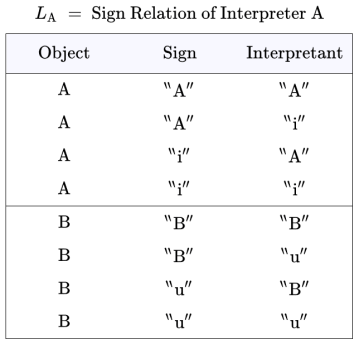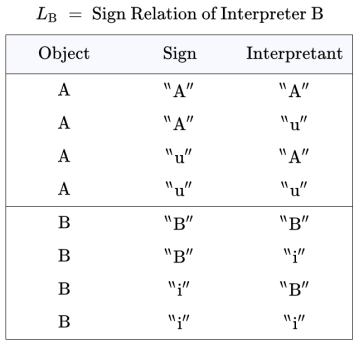Examples from Semiotics
The study of signs — the full variety of significant forms of expression — in relation to all the affairs signs are significant of, and in relation to all the beings signs are significant to, is known as semiotics or the theory of signs. As described, semiotics treats of a 3-place relation among signs, their objects, and their interpreters.
The term semiosis refers to any activity or process involving signs. Studies of semiosis focusing on its abstract form are not concerned with every concrete detail of the entities acting as signs, as objects, or as agents of semiosis, but only with the most salient patterns of relationship among those three roles. In particular, the formal theory of signs does not consider all the properties of the interpretive agent but only the more striking features of the impressions signs make on a representative interpreter. From a formal point of view this impact or influence may be treated as just another sign, called the interpretant sign, or the interpretant for short. A triadic relation of this type, among objects, signs, and interpretants, is called a sign relation.
For example, consider the aspects of sign use involved when two people, say Ann and Bob, use their own proper names, “Ann” and “Bob”, along with the pronouns, “I” and “you”, to refer to themselves and each other. For brevity, these four signs may be abbreviated to the set The abstract consideration of how
and
use this set of signs leads to the contemplation of a pair of triadic relations, the sign relations
and
reflecting the differential use of these signs by
and
respectively.
Each of the sign relations and
consists of eight triples of the form
where the object
belongs to the object domain
the sign
belongs to the sign domain
the interpretant sign
belongs to the interpretant domain
and where it happens in this case that
The union
is often referred to as the syntactic domain, but in this case
The set-up so far is summarized as follows:
The relation is the following set of eight triples in
The triples in represent the way interpreter
uses signs. For example, the presence of
in
says
uses
to mean the same thing
uses
to mean, namely,
The relation is the following set of eight triples in
The triples in represent the way interpreter
uses signs. For example, the presence of
in
says
uses
to mean the same thing
uses
to mean, namely,
The triples in the relations and
are conveniently arranged in the form of relational data tables, as shown below.
Resources
Document History
Portions of the above article were adapted from the following sources under the GNU Free Documentation License, under other applicable licenses, or by permission of the copyright holders.
- Triadic Relation • OEIS Wiki
- Triadic Relation • InterSciWiki
- Triadic Relation • MyWikiBiz
- Triadic Relation • Wikiversity
- Triadic Relation • Wikipedia
cc: Cybernetics • Ontolog Forum • Peirce List • Structural Modeling • Systems Science



>
Pingback: Survey of Relation Theory • 5 | Inquiry Into Inquiry
Pingback: Survey of Relation Theory • 2 | Inquiry Into Inquiry
Pingback: Survey of Relation Theory • 3 | Inquiry Into Inquiry
Pingback: Survey of Relation Theory • 6 | Inquiry Into Inquiry
Pingback: Survey of Relation Theory • 7 | Inquiry Into Inquiry
Pingback: Survey of Relation Theory • 8 | Inquiry Into Inquiry